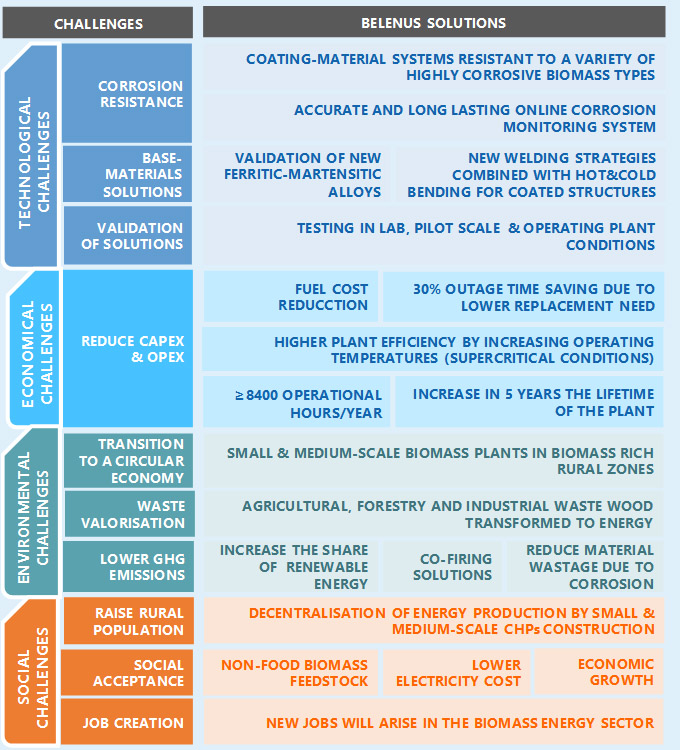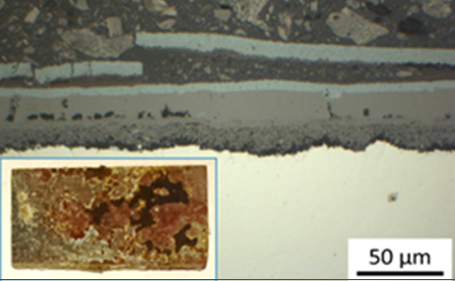Overview

Figure 7. BELENUS´ OVERALL CONCEPT
Overall Concept
Underpinning the Project
BELENUS addresses technological, economic, environmental and social challenges for next generation biomass CHP plants, focusing in achieving sustainable and efficient renewable energy and reducing CO2 emissions.
BELENUS aims to develop a holistic disruptive solutionfor corrosion prevention that will allowplant operation at 580-625°C (metal temperature), reaching efficiencies of ~40-43% while increasing the lifetime of components and plants.
The BELENUS concept aims to validate the best TRL3 available coating/ material systems, weldingstrategies and on-line corrosion monitoringsensors by testing them at TRL5(Figure7).
The impact of BELENUS innovative corrosion solutionin CAPEX and OPEX of energy generation in CHP small and medium-scale plants will be quantified. To accomplish this, BELENUS will focus on three pillars:
PILLAR 1
New Surface Engineering: Biomass corrosion highly resistant coatings on high creep resistance materials
Typical boiler components and SH tubes operating in biomass fired power plants experience high corrosion rates mainly induced by the high amount of chlorine present in the fuel (gas) and/or the present of alkali and heavy metals in condensed deposits (Figure 8).
Therefore, the lifetime of these components is significantly reduced, limiting the operating temperature and thus the efficiency of the biomass plant, as well as significantly increasing the maintenance costs. In many cases, these aggressive conditions imply the use of Ni base alloys.
Creep strength enhanced ferritic and austenitic steels, which can operate up to 625°C[1], are available but they are vulnerable to severe corrosion in biomass combustion environments.
Additionally, the creep-fatigue properties of newly developed steels under intermittent cyclic operation have still to be characterized.An alternative to mitigatecorrosion and allow operation at more aggressive conditions, is the use of highly-corrosion resistant coatings that can significantly increase the life of the plant components, allowing theuse of the above-mentioned lower cost alloys.

FIGURE 8. BIOMASS CORROSION ON BASE MATERIALS

FIGURE 9. NiAl COATING APPLIED BY HVOF SHOWING SUBSTRATE CORROSION THROUGH A DEFECT AFTER 600 h AT 550°C UNDER KCl AND K2SO4 DEPOSITS
Many typesof coating materials have been investigated and used, mostly basedon weld overlays of Ni base alloys, including self-fluxing alloys (NiCrSiB) and composites incorporating ceramic materials such as SiC, Al2O3, Zr2O3, etc[2]. For instance, a cermet coating composed of TiO2 and alloy 625 was estimated to last 27,000 h at a metal temperature of 448°C14.
However, lifetimes at 550°C and higher are still insufficient and most failures are related to coating defects such as pores andcracks, through which the corrosive species reach the substrate (Figure 9).
BELENUS will avoid the use ofexpensive Ni alloys by developing tubing/coatingsystems that will be able to operate at >580°C, reaching higher efficiencies, and increasing their lifetime.
Coatings of different compositions deposited by a range of techniques will be studied, potentially combining different methods appropriate to coat large and complex geometries found in boilers.
The coatings must be flexible in terms of being resistant to different types of biomass.
Overall, the main goal is to deposit very thick and defect-free coatings on low cost high strength steels.
PILLAR 2
New strategies of welding and bending for coated tubes improving the quality and efficiency of boiler components.
Welding is considered as the main technology for assembly and repair of boiler structures which incorporate thousands of welds, for which no alternative is foreseen. It goes hand in hand with a significant thermal influence and the final properties will be strongly influenced by the whole assembly procedure. Creep rupture strength of weldments will differ significantly compared to substrates. The weld strength reduction factor (SRF) is of great importance to estimate loss in creep strength. Especially during the development of new components and residual lifetime, evaluation the SRF is of great interest also for industries[1],[2]. In addition, coated structures will be affected by welding. Therefore, the influence of welding procedures on the compound structure and the integrity of coated boiler components will be studied. An innovative and all-embracing development of a holistic welding strategy in combination with a bending strategy before and/or afterwards will be developed in BELENUS.
[1] H. Cerjak, P. Mayr: Creep resistant steels, Chapter: creep strength of welded joints of ferritic steels, Woodhead, 2008, ISBN 978-1-84569-178-3.
[2] P. Mayr, H. Cerjak: The impact of welding on the creep properties of advanced 9-12% Cr steels, Transactions of the Indian institute of metals, 63, 2010, 131-135
The main questions to be answered are; (i) how the welding and bending procedures affect coated structures in terms of integrity and overall properties and (ii); if low heat input welding processes can be optimised to limit coating damage and avoid additional coating procedures for assembled structures, employing corrosion resistant welding consumables. Assembled structures including welds and/or bends for further corrosion and mechanical testing will be generated within BELENUS. Regarding these items, BELENUS will study and test the following:
- Development of advanced hot and cold bending strategy of coated tubes with their heat treatments.
- Definition of integrity criteria of coated boiler structures after bending and welding.
- Development of welding strategy and description of guidelines for component assembly.
- The weld SRF will be determined.
State-of-the-art boiler fabrication procedures alter the microstructure of the base metal, mainly degrade coatings and affect properties either due to the forming and/or the thermal exposure. Thus, optimised joining strategies will be made available. An innovative element will be the determination of critical peak temperatures to the coating system using thermo-physical forming and welding simulation and transfer of this knowledge into manufacturing.
PILLAR 3
Online corrosion monitoring system
There were few attempts in the past (ECN, DTU, JRC, KEMA, etc.) to monitor high temperature corrosion in power plants and none has been successful due to low durability, not enough accurate signals, etc.[1],[2],[3]The electrochemical ceramic-based composite sensor proposed in BELENU Sis based on electrochemical reactions between materials and corrosive species present in combustion gasesand ash deposits. Through the sensor, a perturbation electrical signal is sent and the sensor acquires the response by recording the linear polarisation, electrochemical impedance spectroscopy and the spontaneous electrochemical noise signal simultaneously, and thus recording in real time, not only the corrosion rate in mm/year (linear polarization resistance), but also detecting the corrosion mechanism (generalized or local corrosion attack) based on electrochemical impedance analysis. When localized attack starts (detected by electrochemical noise) the sensor should warnweeks before a critical failure happens, preventing unplanned shut-downs or accidents.The system will be designed and tested at laboratory scale to achieve reliable measurements up to 8,000 hours. Furthermore, it will be implemented in a real boiler and measures will be taken during 2,000 operational hours to evaluate their response, accuracy and validity. Thus, this sensor will optimize the programmed maintenance stops with more accuracy and anticipate failures.
Pillars 1, 2 and 3 will enhance the operational temperature and pressure improving efficiencies, while reducing operating costs and increasing the flexibility of small and medium-scale biomass CHP plants.
[1] A. Stephan et al, Energy Procedia 120, 2017, 309-316
[2] B. Livingston, Ash Related Issues in Biomass.European Commission 2006
[3] Japanese patent JP2003346791 “Cooling electrochemical devices for measuring high temperature corrosion”



